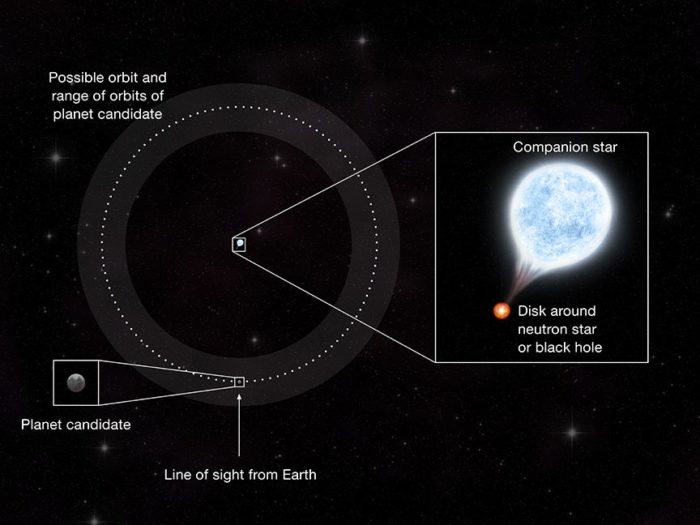Oct 26 2021
Possible Extragalactic Planet
 For most of recorded human history we knew of only those planets that were naked-eye visible (Mercury, Venus, Mars, Jupiter and Saturn). We new these dots of light in the sky were different from the other stars because they were not fixed, they wandered about. The invention of the telescope and its use in astronomy allowed us to study the planets and see that they were worlds of their own, while adding Uranus, Neptune and Pluto to the list. Pluto has since been recategorized as a dwarf planet, with four others added to the list, and many more likely.
For most of recorded human history we knew of only those planets that were naked-eye visible (Mercury, Venus, Mars, Jupiter and Saturn). We new these dots of light in the sky were different from the other stars because they were not fixed, they wandered about. The invention of the telescope and its use in astronomy allowed us to study the planets and see that they were worlds of their own, while adding Uranus, Neptune and Pluto to the list. Pluto has since been recategorized as a dwarf planet, with four others added to the list, and many more likely.
Of course astronomers suspected that our own solar system was not unique and therefore other stars likely had their own planets. The first observation of a disc of material around another star was in 1984, supporting the idea of planet formation around other stars. The first exoplanets (as planets outside our solar system are called) was discovered in 1992, orbiting a pulsar. In 1995 the first planet orbiting a main sequence star (like our own) was discovered. This confirmed the possibility of planetary systems theoretically capable of supporting organic life. So far more than 4,000 exoplanets have been confirmed.
The most common method of detecting an exoplanet is the transit method. For systems where the plane of planetary orbits aligns with the angle of view from Earth, orbiting planets will pass in front of their parent star. Astronomers measure what they call the “light curve” of the star, and when a planet transits the light curve dips then returns to baseline. From this they can infer the size and distance of the planet. If the orbit is short enough, they can confirm the exoplanet and measure its year by detecting multiple transits.
Another method is to measure the path that a star takes as it orbits around the galaxy. Planets will gravitationally tug on their parent star (all such object orbit around their mutual center of gravity), so stars with planets will wobble. If the planet is massive enough, we can detect the wobble and infer the presence of the planet. Yet another method is to directly observe the planet by carefully occluding the star so that the planet’s reflected light can be seen, free from the glare of its sun. Finally there is the microlensing technique, which exploits Einstein’s gravity lens principle. When a planet passes in front of a distant star, the light from that star can be briefly made brighter. The challenge with this method is that microlensing events are single unpredictable events.
All of these methods get more challenging with distance. Astronomers have mostly been focusing on relatively nearby stars for that reason. The only method out of these four that could potentially be useful for looking for exoplanets outside the Milky Way galaxy is microlensing. In 2009 a possible exoplanet in our nearby Andromeda galaxy was seen through microlensing. But again, these are one-off events so there is no way to confirm the observation.
However, astronomers may have found another way to detect an extragalactic exoplanet – using the transit method, not for visible light, but rather for X-rays. The potential planet is in the Whirlpool galaxy (M-51), 28 million light years away. The stellar system they are observing is comprised of either a neutron star or black hole with a companion star that is feeding it material. This process produces X-rays, which we can detect from Earth. There are two big advantages to using the transit method with X-rays. The first is that there are far fewer X-ray sources in a typical galaxy that stars (dozens vs hundreds of billions). While the stars are all crowded together and cannot be resolved, the X-ray source are spread out and can be.
The other advantage is that the X-ray source from a feeding black hole or neutron star is relatively small. If the system is lined up properly, a transiting planet could block most or even all of the X-rays as seen from Earth. That is exactly what happened – the light curve of the X-rays dipped all the way to zero, lasting for about three hours. From this light curve the astronomers calculate that the planet is likely the size of Saturn and orbiting at twice the distance as Saturn. However, the orbital period of the planet is about 70 years, so it would take that long to observe another transit for confirmation.
This is a rare alignment, but fortunately the universe is a big place. The astronomers observed X-ray sources in three different galaxies to find one with a transit. There are billions of other candidates out there, so they can keep looking for more.
What does all this tell us? We won’t be traveling to M-51 anytime soon (probably ever) so who cares if there is a planet in that galaxy occasionally getting zapped with X-rays? For now the goal of exoplanet hunting is to build up a database so that astronomers can get a better idea of how planets form and under what conditions. How many planets are likely out there, and in what sizes and distances from their stars? Using microlensing we can even look for rogue planets not orbiting stars. How typical is Earth’s configuration of planets, and how many planets capable of supporting organic life are there?






